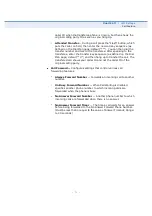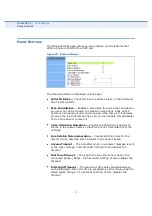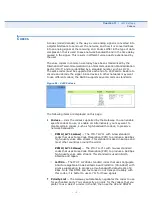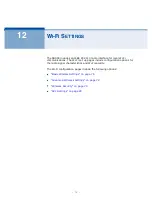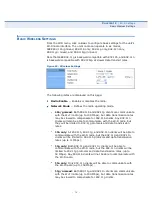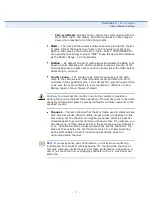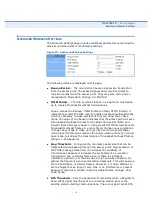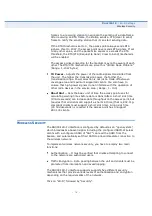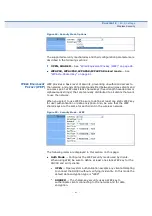
Ý
ØßÐÌÛÎ
ïî
| Wi-Fi Settings
Advanced Wireless Settings
78
ß
ÜÊßÒÝÛÜ
É
×ÎÛÔÛÍÍ
Í
ÛÌÌ×ÒÙÍ
The Advanced Settings page includes additional parameters concerning the
wireless network and Wi-Fi Multimedia settings.
Figure 53: Advanced Wireless Settings
The following items are displayed on this page:
Beacon Period
The rate at which beacon signals are transmitted
from the access point. The beacon signals allow wireless clients to
maintain contact with the access point. They may also carry power-
management information. (Range: 20-999 TUs)
DTIM Period
The rate at which stations in sleep mode must wake
up to receive broadcast/multicast transmissions.
Known also as the Delivery Traffic Indication Map (DTIM) interval, it
indicates how often the MAC layer forwards broadcast/multicast traffic,
which is necessary to wake up stations that are using Power Save
mode. The value of one beacon indicates that the access point will save
all broadcast/multicast frames for the Basic Service Set (BSS) and
forward them after every beacon. Using smaller DTIM intervals delivers
broadcast/multicast frames in a more timely manner, causing stations
in Power Save mode to wake up more often and drain power faster.
Using higher DTIM values reduces the power used by stations in Power
Save mode, but delays the transmission of broadcast/multicast frames.
(Range: 1-255 beacons)
Frag Threshold
Configures the minimum packet size that can be
fragmented when passing through the access point. Fragmentation of
the PDUs (Package Data Unit) can increase the reliability of
transmissions because it increases the probability of a successful
transmission due to smaller frame size. If there is significant
interference present, or collisions due to high network utilization, try
setting the fragment size to send smaller fragments. This will speed up
the retransmission of smaller frames. However, it is more efficient to
set the fragment size larger if very little or no interference is present
because it requires overhead to send multiple frames. (Range: 256-
2346 bytes)
RTS Threshold
Sets the packet size threshold at which a Request to
Send (RTS) signal must be sent to a receiving station prior to the
sending station starting communications. The access point sends RTS








